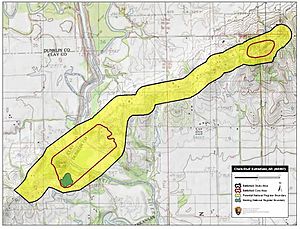Battle of Chalk Bluff facts for kids
Quick facts for kids Battle of Chalk Bluff |
|||||||
|---|---|---|---|---|---|---|---|
| Part of the Trans-Mississippi Theater of the American Civil War |
|||||||
 Chalk Bluff Battlefield |
|||||||
|
|||||||
| Belligerents | |||||||
| Commanders and leaders | |||||||
| Units involved | |||||||
| Marmaduke’s Division | Second Division, Army of the Frontier | ||||||
| Strength | |||||||
| 2,000 | 10,000 | ||||||
| Casualties and losses | |||||||
| 30 killed 60 wounded 120 missing total of 210 men |
23 killed 44 wounded 53 captured total of 120 men |
||||||
The Battle of Chalk Bluff was a fight during the American Civil War. It happened on May 1 and 2, 1863. The battle took place near Chalk Bluff, which is now in Clay County, Arkansas.
Confederate General John S. Marmaduke was trying to cross the St. Francis River. Union General William Vandever tried to stop him. Even though the Confederates won the battle, they lost many soldiers. This forced Marmaduke to stop his mission into Missouri.
Contents
What Led to the Battle?
Marmaduke's Journey to Missouri
In the spring of 1863, General Marmaduke left his camps in Arkansas. He had about 5,000 cavalry soldiers with him. His goal was to go into southeastern Missouri.
Retreat After Cape Girardeau
Marmaduke's forces fought hard at the Battle of Cape Girardeau. But they were defeated there. After that, he began to retreat on April 27. He headed back towards Helena, Arkansas.
Finding a Way to Cross the River
Marmaduke's path followed a road on Crowley's Ridge. This ridge was a long, raised area. It protected his soldiers on the sides. The land around it was mostly swampy. Union forces, led by General Vandever, chased Marmaduke. They followed him through Missouri to Chalk Bluff, Arkansas. Marmaduke planned to cross the St. Francis River there. The river had steep banks made of white clay. This made it very hard for cavalry to cross.
Setting Up Defenses
Marmaduke wanted to protect his men while they crossed the river. So, he set up a rear guard. This group would protect his engineers and pioneers. These workers were building a bridge. The bridge needed to be strong enough for his whole division to cross. He created a first defense line at a small village called Four Mile. He kept his extra soldiers, called reserves, a mile away. They were at Gravel Hill, on top of the ridge. The soldiers started digging trenches. This would help them stop any Union attack.
The Battle Unfolds
Fighting at Chalk Bluff
The fighting started on May 1 and lasted into the next day. General Vandever's Union soldiers tried to push the Confederates off the high ground. But they could not do it. Marmaduke's rear guard lost many soldiers. However, they held off the Union forces long enough. This gave the bridge builders time to finish their work. Marmaduke's main army was then able to cross the river.
Confederate Accounts of the Fight
Because of the many soldiers lost, Marmaduke had to end his mission. He returned to his camp. Confederate reports, including one from General Marmaduke himself, tell a different story. Letters from Confederate soldiers also agree. They said that Union forces lost many soldiers. This happened as they tried to take the dug-in positions on the ridges. General Thompson moved the artillery (cannons) across the river by raft on the first night. So, as Union forces tried to take the ridges, they faced cannon fire. The cannon fire came from their right side. It continued down their long line of soldiers.
What Happened After the Battle?
A Costly Victory
In some ways, Marmaduke won the Battle of Chalk Bluff. He achieved his goal of crossing the river. However, the Union forces saw it as a victory for them too. This is because Marmaduke had to give up his plan to attack in the spring.
Remembering the Battlefield Today
Preserving History
Today, a small place called Chalk Bluff Battlefield Park remembers the battle. It protects part of the land where the fighting happened. This park is listed on the National Register of Historic Places.
Exploring the Battlefield
A walking path called the Chalk Bluff Hiking Trail goes through parts of the battlefield. There are signs and panels along the trail. They explain what happened there. Later in the war, some smaller fights also happened here. Both armies sent groups to control this important river crossing. The towns of Chalk Bluff, Four Mile, and Gravel Hill no longer exist today.

